
NORTHERN BAJA CALIFORNIA OBSIDIAN SOURCES

Figure 1. Known sources of archaeological obsidian in northern Baja California, southern Alta California, and northwestern Sonora as of 2019 (adapted from Panich et al. 2017). Source locations on the map are hot linked to accompanying text.
![]()
BACKGROUND AND GENERAL ARCHAEOLOGICAL GEOCHEMISTRY OF OBSIDIAN SOURCES
For many years, the location, character, and archaeological distribution of sources of archaeological obsidian in Baja California, with a few exceptions, has remained essentially unknown. Now, due mainly to the efforts of Lee Panich (Santa Clara University), and Antonio Porcayo Michelini (INAH, Baja California) this has radically changed. Not only are most major and minor sources located in space and characterized by XRF, the archaeological distribution of these sources in both Baja California and Alta California is becoming clear (Panich et al. 2012, 2015, 2017; Shackley 2019). The source most commonly mentioned in the earlier archaeological literature from Baja California is "San Felipe", where the primary eruptive center is as yet unknown. It is not the most commonly procured obsidian in prehistory, at least in this region, and more importantly has been mis-identified in archaeological contexts on both sides of the border, and more often is the newly described Tinajas source that is located somewhere in far northern Baja California, and is present in archaeological contexts in San Diego County, and Imperial County in southern Alta California (Panich et al. 2017; Shackley 2019). Indeed this laboratory has mis-assigned to San Felipe for years, only recently rectified by Panich and Porcayo's research, and secondarily mine (Shackley 2019). This is primarily because, for geological reasons, many of these Tertiary (Neogene) sources likely dating between 3 and 6 Ma are derived from crustal melting of a Paleozoic metasedimentary and Mesozoic granitoid basement that has a similar composition over a wide region (Barajas et al. 1995; Benoit et al. 2002; Gastil et al. 1975; Nagy et al. 1999; Negrete-Aranda et al. 2013; Saunders et al. 1987; Shackley et al. 2018; Stock et al. 1999). The similarity in composition, at least as derived from XRF, is complicated by the lack of knowledge of the primary sources. Only El Regino, Lágrimas de Apache, and Puerto el Parral have been mapped as a primary source. The rest, including Tinajas are derived from secondary deposits. The sources in the southern portion of this study area, part of the Puertecitos Volcanic Province and the associated tuffs are distributed over a relatively large area, and apparently mixed in the alluvium (see Stock et al. 1999). As can be seen below in Tables 1 and 2 and Figures 2 and 3, only Rb and Zr discriminate at all, and most of these "sources" overlap compositionally indicating that there has been considerable mixing in the alluvium since the Neogene. The best we can do at this point is continue to search for the primary source locations and assign to source with the caveat that this is what is the most likely source, not unlike many other volcanic regions in the North American West (see Shackley et al. 2018).
We, (Panich, Porcayo, and Shackley) offer this online version of the published data on these sources for universal distribution. While the far southern California source of Obsidian Butte on the San Andreas fault trace was the most commonly procured obsidian source in San Diego and Imperial County late prehistory (and volumetrically the largest obsidian source in the region), the Tinajas source and less commonly the San Felipe source is present in important proportions in sites in these counties (Shackley 2019). Finally, the cooperation between U.S. and Mexican archaeology is a testament to the long-term relationship we have enjoyed, in large part due to Señora Julia Bendímez Patterson running the Baja California INAH office (and a graduate of San Diego State University's MA program). This kind of international cooperation is as it should be, and the results benefit all. Parenthetically, the re-assignment of San Felipe to Tinajas is precisely why an adequate knowledge of obsidian sources in a region is of paramount importance for many archaeological reasons.
Table 1. Major and minor oxides for the northern Baja California sources and USGS RGM-1 rhyolite source standard.
|
Sample |
Source |
Na2O |
MgO |
Al2O3 |
SiO2 |
K2O |
CaO |
TiO2 |
MnO |
Fe2O3 |
|
|
|
% |
% |
% |
% |
% |
% |
% |
% |
% |
|
1-1 |
Tinajas |
3.03 |
0 |
7.79 |
73.93 |
8.90 |
2.06 |
0.20 |
0.08 |
3.28 |
|
ALH2 |
El Regino |
2.69 |
0.13 |
8.09 |
66.89 |
9.64 |
3.40 |
0.57 |
0.10 |
6.78 |
|
LA3 |
Lagrimas de Apache |
2.57 |
1.50 |
8.97 |
68.67 |
9.44 |
2.71 |
0.31 |
0.08 |
4.66 |
|
SSF1 |
San Felipe |
3.86 |
0.05 |
12.23 |
75.59 |
4.99 |
0.86 |
0.07 |
0.04 |
1.83 |
|
K3 |
Kierkierly |
3.15 |
0.30 |
7.94 |
71.75 |
9.22 |
2.26 |
0.42 |
0.07 |
3.96 |
|
MT9305-1 |
Puerto el Parral |
3.74 |
0 |
12.81 |
76.24 |
4.12 |
0.84 |
0.14 |
0.03 |
1.72 |
|
RGM1-S4 |
standard |
4.00 |
0 |
13.22 |
73.76 |
4.88 |
1.40 |
0.27 |
0.04 |
2.17 |
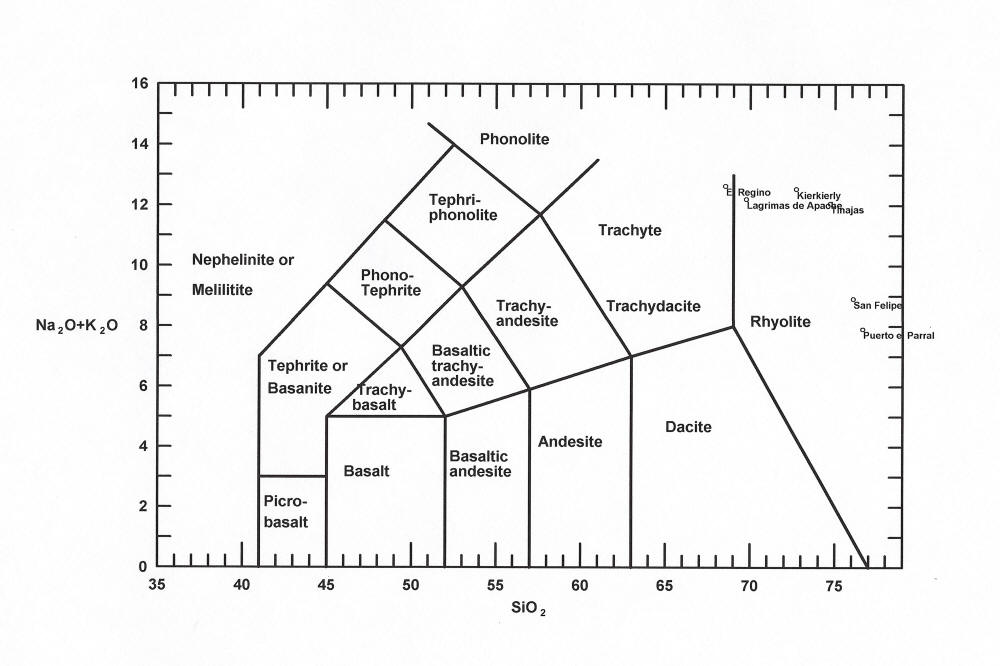
Figure 2. TAS plot of the obsidian sources in Table 1 (Le Maitre et al. 1989). While most of the sources have relatively high alkalis, El Regino is transitional between a trachytic glass and obsidian, partly reflected in its knappable qualities. Tinajas, San Felipe and Puerto el Parral would be considered high-silica rhyolites. Instrumental methods at http://swxrflab.net/anlysis.htm
Table 2. Mean and central tendency for selected elements for the northern Baja California sources (From Panich et al. 2017). All measurements in parts per million (ppm). Sixty-one samples have now been analyzed and that data presented under the Puerto el Parral heading. Analyses at the Geoarchaeological XRF Laboratory, Albuquerque, New Mexico.

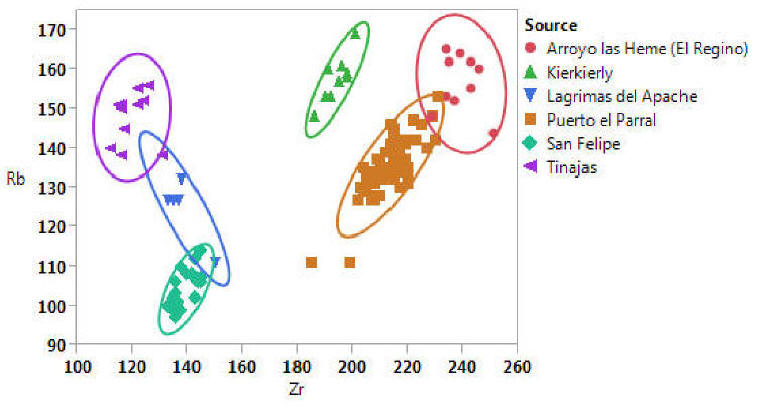

Figure 3. Zr/Rb and Ba/Rb bivariate plots of the northern Baja California obsidian source standards. Analysis from Panich and Shackley collections. Measurements in parts per million (ppm). Confidence ellipses at 95%.
SOURCE DESCRIPTIONS
The descriptions below are adapted from the Panich et al. (2017) publication. Since that study, additional Puerto el Parral samples have been analyzed and included here as mean and central tendency. The source descriptions are generally presented from north to south. At least Puerto el Parral and El Regino exhibit some mahogany (red) colored specimens, not unusual in the North American Southwest (Shackley 2005). Photos by Lee Panich unless noted otherwise.
The obsidian chemical group referred to here as Tinajas obsidian was first noted in an archaeological assemblage from Mission Santa Catalina (dated ca. 1797–1840) in the southern Sierra Juárez of Baja California (Panich 2009). As discussed above it appears to have been common throughout the region, a small sample of obsidian artifacts (n=9) from the mission was originally misattributed to the San Felipe obsidian group (Panich 2009:233–234). However, an expanded XRF analysis of an additional 27 obsidian artifacts from the mission suggested the presence of an as yet unknown source of obsidian with a chemical composition that is slightly different from San Felipe glass, also discussed above (Panich 2010:80; 2011:20–21). This hypothesis has been borne out by further provenance studies of archaeological and geological obsidian in the region (Panich et al. 2012, 2015, 2017). Recent research has provided clues to the location of the primary geological source locality (or localities) of the Tinajas chemical group. Our reconnaissance surveys of secondary geological deposits in the San Felipe-Puertecitos region between 2010 and 2014 suggested that Tinajas obsidian is not geologically available south of the Sierra Juárez. In late 2015 and early 2016, one of us (APM) collected small nodules (measuring < 4 cm in maximum dimension) matching this chemical group from secondary geological deposits in and around the Sierra de las Tinajas, with a particularly rich area of nodules near Tres Pozos at the southwestern extent of the modern Laguna Salada. This zone is roughly halfway between San Felipe and Obsidian Butte, putting the apparent geological source of this obsidian much closer to the modern international border and near the boundary between the Kumeyaay and Cucapá ethnolinguistic provinces. Given the variation in elemental values from archaeological and geological specimens that were examined for this study (also see Panich et al. 2012, 2015), Tinajas obsidian may ultimately represent multiple discrete subsources, typical for Tertiary rhyolite systems in western North America (Shackley et al. 2018). A recent study of over 500 obsidian artifacts from San Diego and western Imperial Counties, California indicated that while Obsidian Butte overwhelmingly dominated late prehistoric assemblages, Tinajas and a lesser extent San Felipe was also present in these sites (Shackley 2019). While Tinajas represented only about 2% of the obsidian assemblages (there was one San Felipe) out of 535 samples from sites at the coast to the Colorado Desert, at Indian Hill (CA-SDI-2537) on the eastern edge of the Peninsular Ranges in far eastern San Diego County over 4% were produced from Tinajas. Artifacts produced from Tinajas obsidian were recovered from sites from western San Diego County into the Peninsular Ranges including prehistoric Kumeyaay mountain sites that were part of the fall gathering of Kumeyaay clans and where obsidian was certainly exchanged with other Kumeyaay including clan relatives (Shackley 2019). While southern Great Basin sources do occur in late prehistoric sites in the region (i.e Coso Volcanic field and Casa Diablo obsidian), at least some of that could be from Archaic occupations, sometimes below the late prehistoric levels as at Indian Hill. Indeed, some of the Tinajas obsidian recovered in mountain sites were finished projectile points that could have been brought to the mountains during the fall as arrows for the deer hunting that certainly occurred at this time. So, it appears that Tinajas was a significant source for Kumeyaay knappers and was distributed throughout Kumeyaay territory indicating contact between desert, mountain, and coastal clans (cimul).
.jpg)
Tres Pozos secondary deposits of Tinajas marekanites (Cerro Capirote in background; left image). Tinajas marekanites in the alluvium at Tres Pozos (right). Photos by Panich and Porcayo.
Lágrimas de Apache (ASU 12-1), was first recorded in 2008 (Porcayo Michelini and Rojas Chávez 2009). Located near the mouth of the Colorado River, it is the northernmost known geological source of obsidian in Baja California (Figure 1), and appears to be most common in Cucupá contexts since the source would have been in or at the boundary of their territory (Panich and Porcayo 2018). The obsidian is found in masses of perlite at the mid-elevations of a volcanic dome covered in rhyolitic boulders and rocks. Possible extraction areas have been noted in three places on the dome; in each area, the surface rocks have been removed to expose the perlite lenses beneath. The perlite contains small, rounded to subangular obsidian marekanites, or unmodiied obsidian nodules, measuring two to five centimeters (cm). The samples analyzed here were obtained directly from the perlite lenses. No debitage or other cultural materials have been noted at the extraction areas (Porcayo Michelini et al. 2011). Thus far, only one artifact analyzed as part of this project—a flaked nodule collected from a site near El Mayor—can be assigned to the Lágrimas de Apache source, suggesting that its use as toolstone may have been limited, although it has also been recovered a El Gran Abrigo by Porcayo.
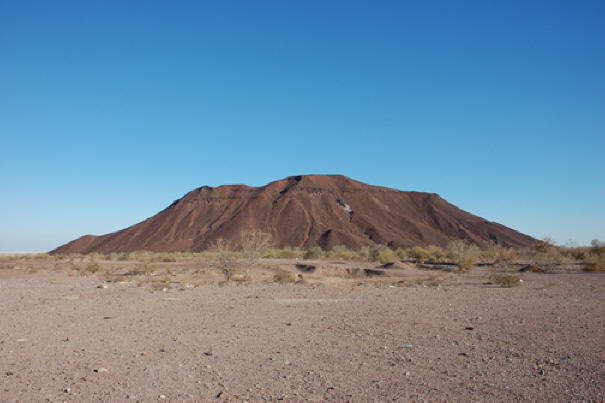
Cerro Lagrimas de Apache and locations of marekanites in situ. Marekanites located in exposed perlite deposits (photos by A. Porcayo)
As noted above, the obsidian referred to as San Felipe glass is perhaps the best known of the sources in Baja California. San Felipe obsidian has previously been reported in archaeological contexts as far north as Riverside and San Diego counties and as far west as the Pacific Coast, although re-examining the data indicates that many of these artifacts were actually produced from Tinajas (Panich et al. 2017; see Laylander 2006; McFarland 2000; Moore 2001), making it the most widely distributed source in northern Baja California. Yet its exact geological source is unknown, and its geochemical signature—which includes one nodule that may be from a separate chemical group (Figure 3)—is derived from samples collected from secondary geological deposits of only vague provenance. Although the terms San Felipe and Arroyo Matomí have occasionally been used synonymously, Bouey’s (1984:55) description of secondary obsidian-bearing deposits north of Arroyo Matomí has long suggested that the San Felipe source is not located in Arroyo Matomí.
Our research supports the notion that the geological source of San Felipe obsidian is well north of Arroyo Matomí. During fieldwork in 2011, Panich and Porcayo collected several unmodified nodules from Los Olivos, a beach where Arroyo Matomí empties into the Gulf of California. None of the samples from this area of the Arroyo Matomí outwash cluster are with the primary group of samples from the San Felipe source (Figure 3). We also noted the presence of unmodified obsidian nodules at a beach approximately 35 km south-southeast of San Felipe. These nodules have not yet been analyzed with comparable methods, but preliminary data using a portable XRF instrument suggest that the nodules are from the San Felipe chemical group. Moreover, the beach is within the general area where the nodules analyzed by Shackley and Bouey were collected decades ago. These two patterns support Bouey’s (1984:55) observation that San Felipe obsidian is not present in Arroyo Matomí. The primary source locality for San Felipe obsidian, however, remains unknown. Recently Panich and Porcayo found San Felipe marekanites on a beach at the southern edge of the city of San Felipe proper, likely near where Shackley procured some in the early 1970s, included in these analyses. So, it seems that San Felipe obsidian has an even wider distribution in secondary contexts that we originally thought.
San Felipe marekanites in the Sierra de San Felipe (photos by Panich and Porcayo)
As discussed above, the Puerto el Parral source was the first geological source in the region to be definitively located and characterized using comparable quantitative methods. A sample of marekanites from the primary source was sent to Shackley in the 1990s from Joann Stock of CalTech in Pasadena, who's research includes the Puertocitos Volcanic Province, of which Puerto el Parral is a part (Stock et al. 1999). Recently Lee Panich and Antonio Porcayo visited the source, images from that visit are included below. The character of Puerto el Parral obsidian is typical of Neogene sources in the North American Southwest (Shackley 2005). Marekanite remnants within perlitic and rhyolite lava matrices are eroding downslope, presumably into Arroyo Matomí. This erosive process was observed at the source (see images below). The primary source lies directly south of Arroyo Matomí northwest of Puertecitos in the northern extent of the Sierra Santa Isabel (see Figure 1). The source exhibits abundant nodules embedded in perlitic lava. The archaeological distribution of Puerto el Parral glass extends to the Pacific Coast in the San Quintín-El Rosario region, where Moore (2001) reported that it was recovered from multiple sites from varying temporal contexts. Given its proximity to Arroyo Matomí, we suspect that Puerto el Parral is the same obsidian previously referred to by some researchers as “Arroyo Matomí.” It should be noted, however, that other researchers have used the terms Arroyo Matomí and San Felipe synonymously (Panich et al. 2010). Future researchers will thus need to compare the original elemental data for obsidian artifacts to the growing list of geological sources in the region to determine the accuracy of previous source assignments (see Tables 2 and 3).
Table 3. Mean and central tendency for Puerto el Parral source standards. All measurements in parts per million (ppm).
Images of Puerto el Parral (photos by L. Panich)
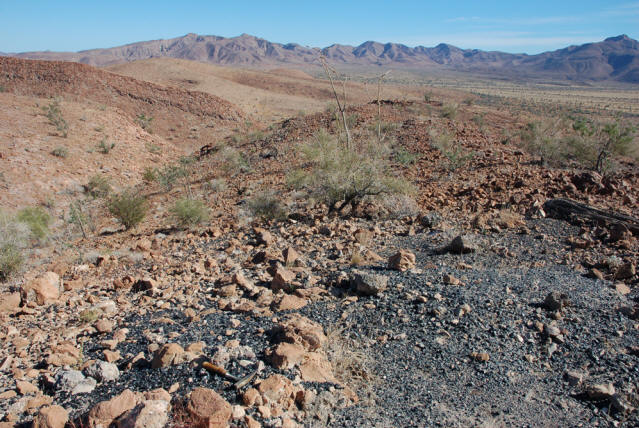
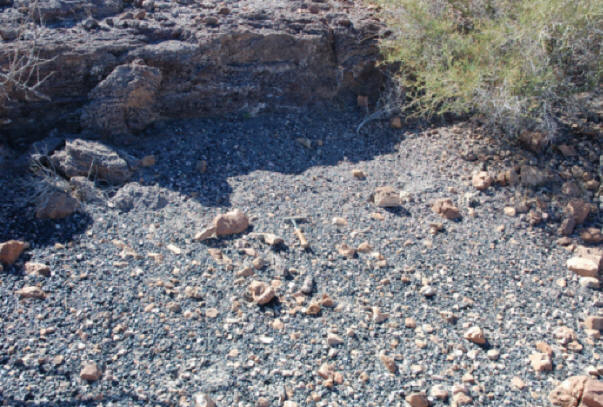
An additional chemical group that suggests an unknown geological obsidian source derives from two unmodified nodules collected from an arroyo during the survey of a plot of land dubbed Kiekierly, located on the Gulf of California coast approximately five km south of Puertecitos on the eastern slope of the Sierra Santa Isabel. These nodules also exhibit elemental concentrations that failed to match the existing chemical signatures of obsidian sources in the region (Figure 3, Table 2). Subsequent visits to the area have documented the presence of numerous obsidian nodules in the arroyo outwash and beach, suggesting a primary source locality further inland in the arroyo system. Interestingly, an obsidian nodule collected by
Porcayo from an archaeological site in the Laguna Chapala region clusters with the Kiekierly obsidian.
A Kiekierly nodule on the beach (photo by Panich and Porcayo)
El ReginoEl Regino is a broadly distributed obsidian chemical group, named for a primary source locality near a small prehistoric rockshelter approximately 10 km south of Puertocitos. The geological obsidian deposits were discovered during archaeological reconnaissance for the San Felipe-Laguna Chapala Highway Project (Porcayo Michelini and Rojas Chávez 2011), and the primary source locality at El Regino is an area of volcanic tuff that includes small, rounded to subangular obsidian marekanites up to five cm in diameter. The source is near Arroyo Los Heme and is less than five km north of Volcán Prieto. The samples analyzed as part of this project were collected from the surface and from secondary deposits associated with road construction at the El Regino site. Preliminary survey suggests that obsidian nodules with similar chemistry are present in Arroyo Los Heme as well as beaches associated with Arroyo el Huerfanito some 15 km south of El Regino (Panich et al. 2012). The geographic extent of the obsidian chemical group noted at El Regino and surrounding areas is a subject of continuing research.
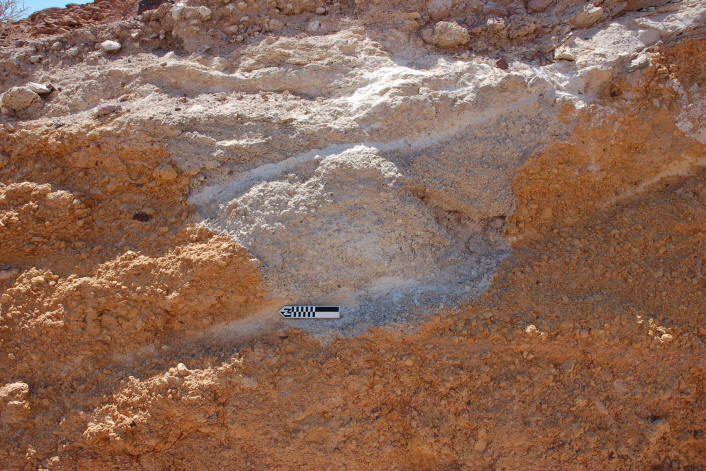
El Regino sediments in road cut (left), and marekanites in tuff (photos by A. Porcayo).
As with Lágrimas de Apache, El Regino obsidian has not been noted in many archaeological assemblages, although sample size may be an issue, as only a small quantity of archaeological obsidian from northeastern Baja California has been analyzed with knowledge of the new chemical groups reported here. A small rockshelter with prehistoric archaeological deposits is located directly on top of the obsidian-bearing strata at El Regino (Porcayo Michelini and Rojas Chávez 2011), and while no worked obsidian was recovered from the archaeological excavations, multiple small nodules were present in the cultural strata. All of the nodules recovered archaeologically from the El Regino rockshelter, including several red obsidian nodules, are part of the broader El Regino chemical group. One flake of El Regino obsidian was identified at Caro’s Cave, another small prehistoric rockshelter, located approximately 3.5 km south of the southernmost extent of the El Regino obsidian nodules in secondary geological contexts. This is the only non-rhyolite glass in the region, and technically is classified as a relatively high Si trachytic glass relatively rare on earth, particularly as a glass that is artifact quality, even if marginally so (Cousens et al. 2003).
References Cited/Bibliography
Banks, T.J. 1971, Geologic Obsidian Sources for Baja California. Pacific Coast Archaeological Society Quarterly 7(1):24–26.
Benoit, M. A. Aguillón-Robles, T. Calumu, R.C. Maury, H. Bellon, J. Cotten, J. Bourgois, and F. Michaud, 2002, Geochemical diversity of Late Holocene volcanism in southern Baja California, Mexico: implication of mantle and crustal sources during and asthenospheric window. Journal of Geology 110:627-648.
Bouey, P. D.1984, Obsidian Studies and Their Implications for Prehistory. Pacific Coast Archaeological Society Quarterly 20(1):55–60.
Cousens, B.L., D.A. Clague, and W.D. Sharp, 2003, Chronology, chemistry, and origin of trachytes from Hualalai Volcano, Hawaii. Geochemistry, Geophysics, Geosystems 4:1-27.
Douglas, R. D. 1981, An Archaeological Reconnaissance in Arriba de Arroyo Matomí, Baja California Norte. Pacific Coast Archaeological Society Quarterly 17(1):63–69.
Gastil, R.G., R.P. Phillips, and E.C. Allison, 1975, Reconnaissance geology of the State of Baja California. Geological Society of America Memoir 140, 170 p.
Laylander, D. 2006, Obsidian studies and Baja California's Prehistory. Memorias Balances y Perspectivas 2005: IV Encuentro Binacional-La Antropología e Historia de Baja California (CD ROM). Centro INAH Baja California, Mexicali.
Le Maitre, R.; Bateman, P.; Dudek, A.; Keller, J.; Lameyre, J.; Le Bas, M.; Sabine, P.; Schmid, R.; Sorensen, H.; Streckeisen, A.; Woolley, A.; Zanettin, B. 1989. A classification of igneous rocks and glossary of terms: Recommendations of the International Union of Geological Sciences Subcommission on the Systematics of igneous rocks (Le Maitre, R.W.; editor). Blackwell, 193 p. Oxford.
Martín-Barajas, A., J. M. Stock, P. Layer, B. Hausback, P. Renne, and M. López-Martínez, 1995, Arc-rift transition volcanism in the Puertocitos Volcanic Province, northeastern Baja California, Mexico. GSA Bulletin 107:407-424.
McFarland, S. L. 2000, Changes in Obsidian Exchange in Southern California. Unpublished Master’s thesis, Department of Anthropology, San Diego State University, California.
Moore, J. D. 2001, Extensive Prehistoric Settlement Systems in Northern Baja California: Archaeological Data and Theoretical Implications from the San Quintín-El Rosario Region. Pacific Coast Archaeological Society Quarterly 37(4):30–52.
Nagy, E.A., M. Grove, and J.M. Stock, 1999, Age and stratigraphic relationships of pre- and syn-rift volcanic deposits in the northern Puertecitos Volcanic Province, Baja California, Mexico. Journal of Volcanology and Geothermal Research 93:1-30.
Negrete-Aranda, R., J. Contreras, and R. M. Spelz, 2013, Viscous dissipation, slab melting, and post subduction volcanism in south-central Baja California, Mexico. Geosphere 9:1714-1728.
Panich, L.M. 2009, Persistence of Native Identity at Mission Santa Catalina, Baja California, 1797–1840. Unpublished Ph.D. dissertation, Department of Anthropology, University of California, Berkeley.
Panich, L.M., A. Porcayo M., M.S. Shackley, 2012, Obsidian sources of Northern Baja California. California Archaeology 4:183-200.
Panich, L.M., É. Morachel M., and A. Porcayo M., 2015, Exploring patterns of obsidian conveyance in Baja California, Mexico. Journal of California and Great Basin Anthropology 35:257-274.
Panich, L. M., M.S. Shackley, and A. Porcayo M., 2017, A reassessment of archaeological obsidian from southern Alta California, and northern Baja California. California Archaeology 9:53-77.
Panich, L. M., and A. Porcayo M., 2018, Following the obsidian trail: clues to prehistoric exchange networks in Baja California. Memorias: Balances y Perspectivas de la Antropología e Historia de Baja California 18:56-64. Ensenada.
Porcayo Michelini, A., and J. Martín Rojas Chávez, 2009, Informe de la Tercera Temporada de Campo del Proyecto Registro y Rescate de Sitios Arqueológicos de Baja California Fase Municipio de Mexicali y Propuesta para la Cuarta
Temporada de Campo 2010. Centro INAH Baja California, Mexicali.Porcayo Michelini, A., and J. Martín Rojas Chávez, 2011, Informe de la Quinta Temporada de Trabajo de Campo del Proyecto Registro y Rescate de Sitios Arqueológicos de Baja California Fase Municipio de Mexicali y Propuesta para la Sexta Temporada de Campo. Centro INAH Baja California, Mexicali.
Saunders, A.D., G. Rogers, G.F. Marriner, D.J. Terrell, and S.P. Verma, 1987, Geochemistry of Cenozoic volcanic rocks, Baja California, Mexico: implications for the petrogenesis of post-subduction magmas. Journal of Volcanology and Geothermal Research 32:223-245.
Sawlan, M.G., and J.G. Smith, 1984, Petrologic characteristics, age and tectonic setting of Neogene volcanic rocks in northern Baja California Sur, Mexico. In Frizell (Ed.), Geology of the Baja California Peninsula. Society of Economic Paleontologists and Mineralogists, Pacific Section 39:237-251.
Shackley, M.S. 2005, Obsidian: Geology and Archaeology in the North American Southwest. Tucson: University of Arizona Press.
Shackley, M.S. 2019, Natural and cultural history of the Obsidian Butte source, Imperial County, California. California Archaeology 11(1): 21-43.
Shackley, M.S., J.R. Hyland, and María de la Luz Gutiérrez M., 1996, Mass production and procurement at Valle del Azufre: a unique archaeological obsidian source in Baja California Sur. American Antiquity 61:718-731.
Shackley, M.S., L.E. Morgan, and D. Pyle, 2018, Elemental, isotopic, and geochronological variability in Mogollon-Datil Volcanic Province archaeological obsidian, southwestern USA: solving issues of inter-source discrimination. Geoarchaeology 33:486-497.
Sosa, A.D., 2014, Obsidian exchange in prehistoric Baja California: an initial look at regional exchange networks in the peninsula. Master's thesis, Department of Anthropology, California State University, Northridge.
Stock, J.M., C.J. Lewis, and E. A. Nagy, 1999, The tuff of San Felipe: an extensive middle Miocene pyroclastic flow deposit in Baja California, Mexico. Journal of Volcanology and Geothermal Research 93:53-74.
![]()
This page maintained by Steve Shackley
Revised: 01 December 2019
![]() Back to
the SW obsidian source page.
Back to
the SW obsidian source page.
![]()